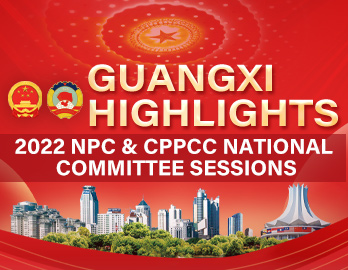History
According to archaeological discoveries, primitive humans settled in Guangxi as early as 800,000 years ago.
Baise Paleolithic Site is the earliest site discovered in Guangxi, and the unearthed Baise Handaxe is 803,000 years old.
About 50,000 years ago, Guangxi entered the late Paleolithic Age.
Between 10,000 and 6,000 years ago, ancient humans in Guangxi gradually moved from caves and river valleys to plains and coastal areas to develop primitive agriculture, animal husbandry and pottery making. Typical ancient human sites include Bose Paleolithic Site, Liujiang Man Site, Liuzhou Bailiandong Site, and Guilin Zengpiyan Site. On May 1, 1981, Professor Pei Wenzhong, a paleoanthropologist, wrote an inscription for Liuzhou Bailiandong Site: "China will become the center of paleoanthropological research, while Guangxi will become the center of China".
After the First Emperor of Qin unified Lingnan, Guangxi was included in the territory of the central dynasty and belonged to Guilin Prefecture and Xiang Prefecture.
From the end of Qin Dynasty (221-206 BC) to the beginning of Han Dynasty (206 BC-220), Guangxi belonged to the Nanyue Kingdom established by Zhao Tuo. In the sixth year of the Yuanding Period of the Western Han Dynasty (111 BC), Emperor Wu quashed the revolt in Nanyue, and set up Cangwu Prefecture, Yulin Prefecture and Hepu Prefecture. By that time, Hepu had become the starting port of the Maritime Silk Road, and Lingqu-Hepu had become an important passage linking the Central Plains and the South.
During the Eastern Han Dynasty (25-220), Jiaozhou (administration center: Guangxin, now Wuzhou City) was established, which was a unified first-level administrative region governing Guangdong, Guangxi and north and central Vietnam.
During the Three Kingdoms, Liang-Jin and Northern-Southern Dynasties, Guangxi first belonged to Wu, and then belonged to Song, Qi, Liang and Chen in the Jin and Southern Dynasties.
After the downfall of the Chen Dynasty, there were five prefectures - namely Ningyue, Yongping, Hepu, Yulin and Shi'an - and 85 counties in Guangxi.
At the beginning of the Tang Dynasty (618-907), most of Guangxi belonged to Gui, Rong and Yong of Lingnan. In the third year of the Xiantong Period (862), Lingnan was divided into East and West, and the military governor of Yong was designated as the military governor of Lingnan, which indicated that Guangxi had become a first-level independent administrative region.
During the period of the Five Dynasties and Ten Kingdoms (907-960), the Chu regime fought with Nanhan regime for a long time, which caused severe social and economic damage to Guangxi.
In the early Song Dynasty (960-1279), most of Guangxi belonged to Guangnan. In the third year of the Zhidao Period (997), Guangnan was divided into East Guangnan and West Guangnan, and most of Guangxi was part of West Guangnan (hence the name Guangxi).
During the Yuan Dynasty (1271-1368), Guangxi belonged to Huguang Province. In the twenty-third year of Zhizheng Period (1363), Guangxi Province was officially established. The Guangxi administrative region introduced the system of province, prefecture, and county, which laid the foundations for the current Guangxi.
During the Hongwu Period of the Ming Dynasty (1368-1644), Guangxi became one of the 13 provinces. After the fall of the Ming Dynasty, the northern Guangxi area was under the jurisdiction of Guangxi, but coastal areas such as Qinlian came under the jurisdiction of Guangdong.
At the beginning of the Qing Dynasty (1644-1911), Guangxi experienced several wars such as the Anti-Qing wars and the Revolt of the Three Feudatories. During the Qing Dynasty, the bureaucratization of native officers was implemented, and the native chieftain system gradually declined, before finally dying out during the Republic of China. After the mid-Qing Dynasty, the Heaven and Earth Society (an anti-Qing organization) developed rapidly in Guangxi. After the outbreak of the First Opium War, anti-imperialist and anti-feudal struggles flourished in Guangxi. In 1851, the Taiping Rebellion and the anti-Qing rebellion led by the Heaven and Earth Society broke out in Guangxi, and the conflicts between the people and the Western churches intensified. In 1856, the Second Opium War started. In 1883, the Sino-French war broke out. In the face of French aggression, Guangxi's military and civilians fought back and achieved a victory at Zhennanguan. At the end of the Qing Dynasty, due to the economic invasion of imperialist powers, Guangxi's small peasant economy was severely damaged, the people became increasingly impoverished, and the society was unstable.
After the outbreak of the Revolution of 1911, Guangxi Revolutionaries organized the Liuzhou and Xunzhou rebellions and declared the independence of Guangxi. However, the Old Kuangsi Clique, led by the warlord Lu Rongting, then seized power and began the mass murder of revolutionaries. In 1921, Sun Yat-sen launched a war against Lu Rongting and established a provincial government chaired by Ma Junwu, but the actual power of the provincial government was controlled by the warlord Chen Jiongming. In the summer of 1922, Chen Jiongming ordered the main force of the Guangdong Army to withdraw from Guangxi, then Ma Junwu resigned, and Guangxi fell into an anarchic state. In 1925, the New Guangxi Clique led by Li Zongren took power in Guangxi.
The New Guangxi Clique supported the KMT-CPC cooperation at first. In October 1925, the Guangxi branch of the CPC was first established in Wuzhou. After a counter-revolutionary coup on April 12, 1927, the New Guangxi Clique began to oppose the CPC, and Guangxi's revolutions were in the doldrums. But then the conflicts between Chiang Kai-shek and the New Guangxi Clique intensified. From 1929 to 1930, Deng Xiaoping, Zhang Yunyi, Wei Baqun, Li Mingrui, Chen Haoren and others launched the Bose Uprising and the Longzhou Uprising, and established the 7th and 8th Corps of the Chinese Workers' and Peasants' Red Army and the Zuojiang and Youjiang Revolutionary Bases.
During the period of the New Guangxi Clique, the group carried out construction in many fields such as military and politics. During this period, Guangxi's modern industrial, agricultural, cultural and educational undertakings developed rapidly. After the September 18th Incident, the New Guangxi Clique launched the Incident in Guangdong and Guangxi with Guangdong warlord Chen Jitang. However, the frequent use of military forces caused a heavy burden on the people and intensified social conflicts.
After the outbreak of the War of Resistance against Japan, Guangxi was invaded by Japanese troops twice, in 1939 and 1944-1945. Most of the areas were occupied, the central city and the main traffic areas were looted. After the victory of the War of Resistance Against Japan, the New Guangxi Clique launched an anti-CPC civil war. But the CPC organizations at all levels continued guerrilla warfare in 97 counties. On November 7, 1949, the People's Liberation Army launched the campaign to liberate Guangxi, and placed a red flag on Zhennanguan on December 11, 1949, marking the liberation of Guangxi.
In February 1950, the People's Government of Guangxi Province was established in Nanning. Starting in the winter of 1950, Guangxi began a program of land reform. In May 1951, Guangxi bandits were basically eliminated and social order was fully restored. At the end of 1952, the restoration of Guangxi's economy was completed. In May 1954, Guangxi's land reform was fully completed, which aroused farmers' enthusiasm for production. From 1953 to 1956, through three major reforms, the basic system of socialism was initially established in Guangxi. During the first five-year plan, Guangxi's industry and agriculture developed fast, and the rate of economic development reached the national average. On July 15, 1957, the Fourth Session of the First National People's Congress passed a resolution on the establishment of the Guangxi Zhuang Autonomous Region. On March 5, 1958, the Fourth Session of the First People's Congress of the Guangxi Zhuang Autonomous Region was held, proclaiming the establishment of the Guangxi Zhuang Autonomous Region. In 1965, Beihai, Qinzhou and other coastal areas of the Beibu Gulf were brought under Guangxi's administration. In 1978, December 11 (the anniversary of the Bose Uprising) was designated as the anniversary of the establishment of the autonomous region. Since the period of reform and opening up began, Guangxi has entered a new historical period of national unity and progress, and rapid economic and social development.


